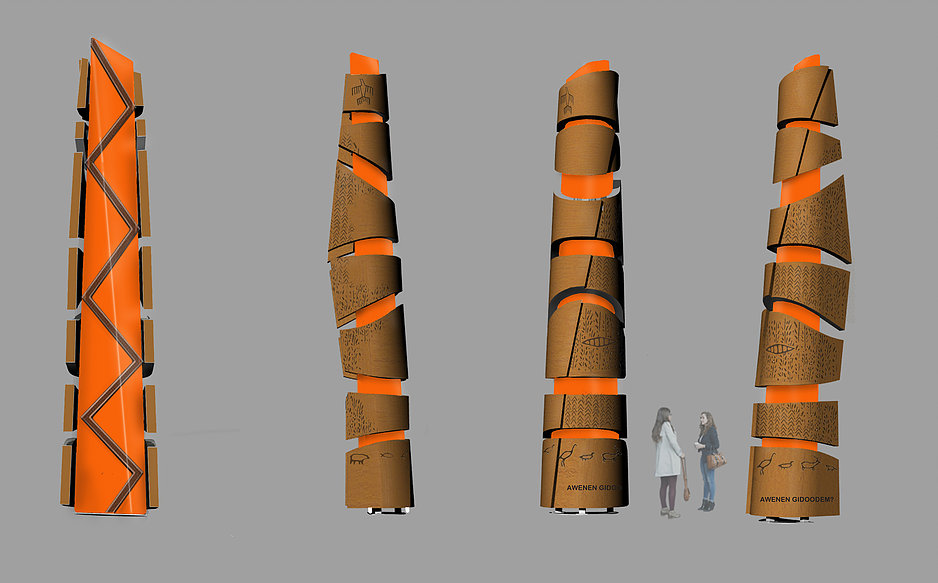Humber Unveils Indigenous Cultural Markers
Humber College has announced that it is honouring Indigenous voices and experiences with the installation of Indigenous Cultural Markers (ICMs) on the college’s campuses. The ICMs are designed to place the college in the context of the long history of Indigenous peoples in what is now called the Greater Toronto Area.
The Honourable Elizabeth Dowdeswell, Lieutenant Governor of Ontario, will be in attendance at a Grand Opening event on November 8, to offer congratulatory remarks.

“The inspiration for the Indigenous Cultural Markers came from the desire to find a contemporary way to explore the land acknowledgement for the geographic area where Humber is located,” says Shelley Charles, dean, Indigenous Education and Engagement. “It’s our responsibility to ensure we provide as many histories as possible in the education and knowledge we impart.”
The Great Migration markers at the Lakeshore Campus tell the migration story of the Anishinaabe people. The Markers feature several key stopping points along the journey from the Eastern shores of Turtle Island to the Western end of Ojibwe Gitchi-Gameh (today’s Lake Superior).
Humber College is located in Adoobiigok, known as “Place of the Black Alders” in the Ojibwe Anishinaabe language. It is uniquely situated along GabeKanang Ziibi, the Humber River providing an integral connection for Indigenous peoples between the northern shore of Lake Ontario and the Lake Simcoe Georgian Bay region.
Brook McIlroy architects Ryan Gorrie and David Thomas served as the lead designers for this project. Humber’s Indigenous Cultural Markers are currently being displayed as part of Gorrie’s participation in UNCEDED: Voices of the Land, a showcase of Indigenous architects from Turtle Island (Canada and the USA) at the 2018 Venice Biennale of Architecture.
The Team
Ryan Gorrie—Architect, Design Co-Lead, Project Manager (Anishinaabe)
David Thomas—Intern Architect, Design Co-Lead (Anishinaabe)
Larissa Roque—Intern Architect, Designer (Anishinaabe)
Danielle Desjarlais—Designer (Cree)
Tiffany Creyke—Designer (Tahltan)
Andrea Mantin—Exhibit Designer, Project Manager, Landscape Architect (Acadian)
Shelley Charles—Elder and Advisor
Jim Dumont—Elder
| Event: | Humber Indigenous Cultural Markers Grand Opening |
| Date: | Thursday, November 8, 2018 |
| Time: | 10 a.m to 12 p.m. |
| Location: | Centre for Entrepreneurship, G Building, Lakeshore Campus 17-3155 Lake Shore Blvd. W., Etobicoke, Ontario, M8V 4B7 |
| At the Event | Shelley Charles, dean, Indigenous Education and Engagement; The Honourable Elizabeth Dowdeswell, Lieutenant Governor of Ontario; Ryan Gorrie, architect, Brook McIlroy; Jingle Dress dancers, smudging ceremony |
The development of the markers and their associated stories were guided and informed by Shelley Charles, the college’s Aboriginal Education Council, as well as Indigenous students. This project aligns with Humber’s new Strategic Plan and the priority to honour authentic Indigenous voices. As a signatory to Colleges and Institutes Canada’s Indigenous Education Protocol, Humber is committed to advancing cross-cultural engagement, mutual respect and understanding.
Established in 1967, Humber College is a global leader in polytechnic education. Combining in-depth theoretical learning and hands-on experience with applied research and extensive industry connections, Humber provides career-focused education to 33,000 full-time and 23,000 part-time students across three campuses. The college offers a comprehensive range of credentials including honours undergraduate degrees, postgraduate certificates, diplomas, apprenticeships and certificates. More than four out of five Humber graduates are employed within six months of completing their studies.























